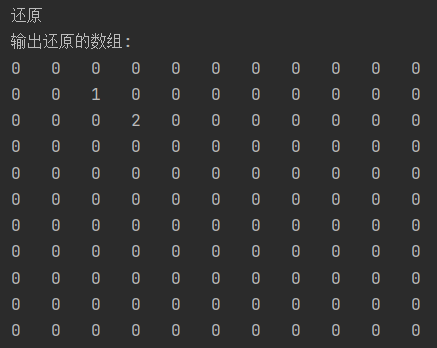catalogue
3. Three kinds of initialization
4. Four basic characteristics of arrays:
I Array overview
An array is an ordered collection of data of the same type
Array describes several data of the same type, which are arranged and combined in a certain order
Among them, each data is called an array element, and each array element can access them through a subscript
II Array declaration creation
1. Array declaration
Array variables must be declared before they can be used in programs. The following is the syntax for declaring array variables
dataType[] arrayRefVar;//Preferred method or dataType arrayRefVar[];//Same effect, but not preferred //Example of data type array name: int array1 [];
The Java language uses the new operator to create arrays. The syntax is as follows:
dataType[] arrayrefVar = new dataType[arraySize];
The elements of the array are accessed through the index. The array index starts from 0
Get array length: arrays length
//Type of variable name of variable = value of variable;
//Array type
int[] nums; //Declare an array
nums = new int[10];//Create an array
//int[] nums = new int[10]; Declare and create
for (int i = 0; i < nums.length; i++) {
nums[i] = i+1;
}
//Assign values to array elements
//Calculate the sum of all elements
int sum =0;
//Get array length: array length
for (int a = 0; a < nums.length; a++) {
sum+=nums[a];
}
System.out.println("The sum is:"+sum);//Total: 552. Memory analysis
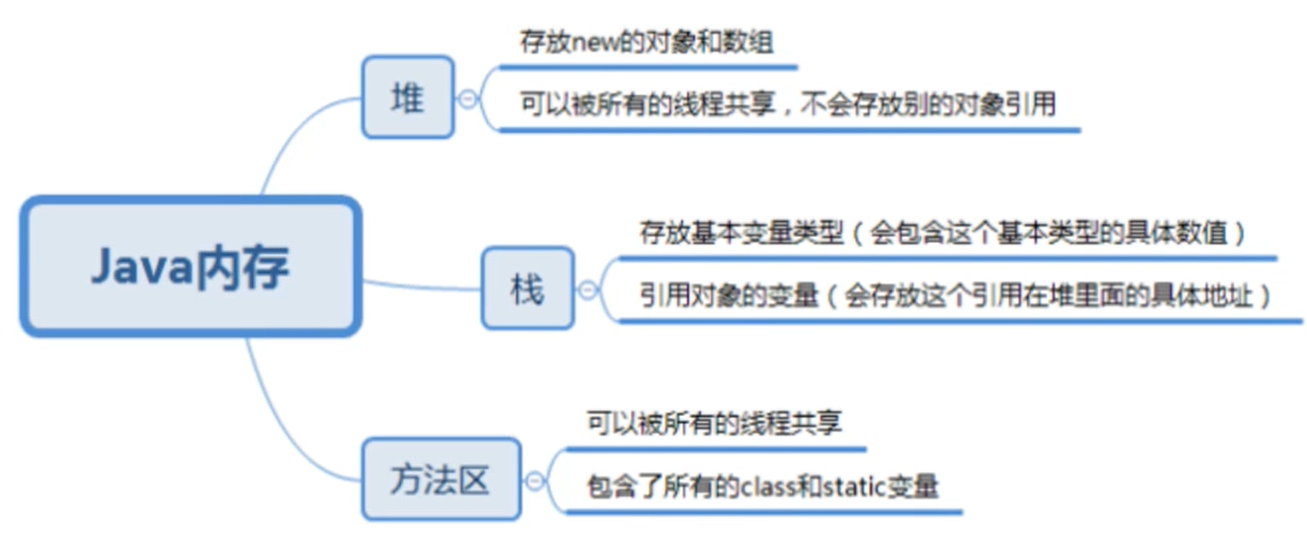
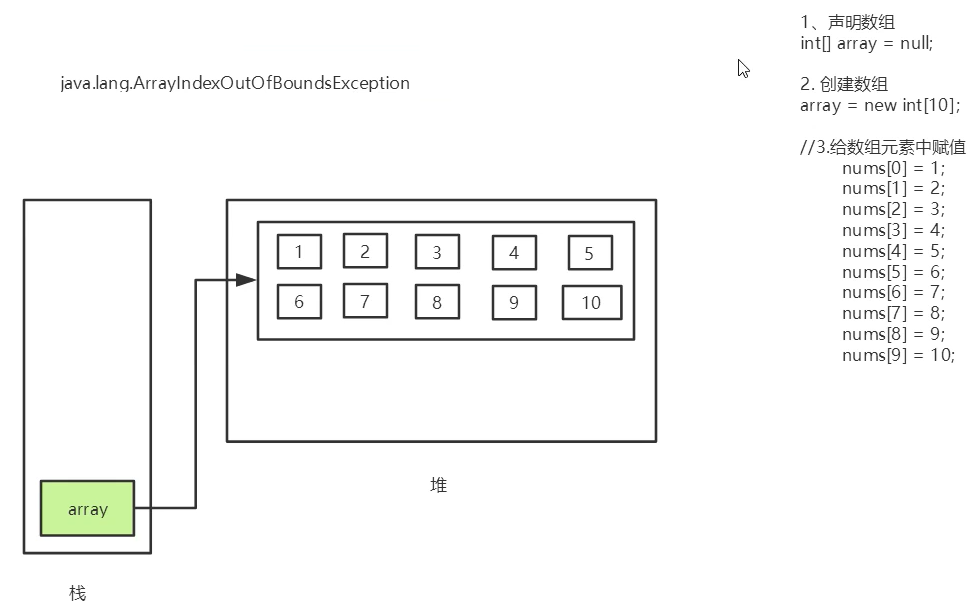
3. Three kinds of initialization
1. Static initialization:
int[] a = {1,2,3};
2. Dynamic initialization
int[] a = new int[2]; a[0] = 1; a[1] = 2;
Default initialization of array:
Array is a reference type, and its elements are equivalent to the instance variables of the class. Therefore, once the array is allocated space, each element in it is implicitly initialized in the same way as the instance variables.
//Static initialization: create + assign
int[]a = {1,2,3,4,5,6,7,8};
System.out.println(a[0]);// 1
//Dynamic initialization: contains default initialization
int b[] = new int[10];
b[0] = 10;
b[1] = 12;
System.out.println(b[0]);// 10
System.out.println(b[1]);// 12
System.out.println(b[2]);// 0
System.out.println(b[3]);// 04. Four basic characteristics of arrays:
1. Its length is determined. Once an array is created, its size cannot be changed.
2. Its array elements must be of the same type, and mixed types are not allowed.
3. The elements in the array can be any data type, including basic type and reference type.
4. Array variable belongs to reference type, and array can also be regarded as variable. Each element in the array is equivalent to the member variable of the object. The array itself is an object, and the Java object is in the heap. Therefore, the array itself is in the heap whether it saves the original type or other object types.
5. Array boundary
The legal range of the subscript: [0,length-1]. If it exceeds the range, an error will be reported;
public static void main(String[] args) {
int[] a = new int[2];
System.out.println(a[2]);
}ArrayIndexOutOfBoundsException: array index out of bounds exception
Summary:
An array is an ordered collection of the same data type (the data type can be any type)
Arrays are also objects. An array element is equivalent to a member variable of an object
The array length is fixed and immutable. If the boundary is exceeded, an error is reported: ArrayIndexOutOfBounds
III Array usage
1. Ordinary For loop
2. For each cycle
int[] array = {1,2,3,4,5};
//Print all array elements
for (int i = 0; i < array.length; i++) {
System.out.println(array[i]); // 1 2 3 4 5
}
System.out.println("===============================");
//Calculate the sum of all elements
int sum = 0;
for (int i = 0; i < array.length; i++) {
sum+=array[i];
}
System.out.println("sum="+sum);// sum = 15
System.out.println("==================================");
//Find maximum element
int max =array[0];
for (int i = 1; i < array.length; i++) {
if (array[i]>max){
max = array[i];
}
}
System.out.println("max = "+max);// max = 5
}3. Array method input parameters
4. Array as return value
int[] arrays = {1,2,3,4,5};
//jdk1.5 No subscript
// for (int array : arrays) {
// System.out.println(array);
// }
printArray(arrays);// 1 2 3 4 5
System.out.print("=========================");
int[] reverse = reverse(arrays);
printArray(reverse);// 5 4 3 2 1
}
//Invert array
public static int[] reverse(int[] arrays) {
int[] result = new int[arrays.length];
//Reverse operation
for (int i = 0,j = result.length-1; i < arrays.length ; i++,j--) {
result[j] = arrays[i];
}
return result;
}
//Print array elements
public static void printArray(int[] arrays) {
for (int i = 0; i < arrays.length; i++) {
System.out.print(arrays[i]+" ");
}
}IV Multidimensional array
Multidimensional arrays can be regarded as arrays. For example, a two-dimensional array is a special one-dimensional array, and each element is a one-dimensional array
2D array:
int a [][] = new int[2][5];
Analysis: the above array a can be regarded as an array with two rows and five columns
//[4] [2] object oriented
/*
1,2 array[0]
2,3 array[1]
3,4 array[2]
4,5 array[3]
*/
int [][] array = {{1,2},{2,3},{3,4},{4,5}};
for (int i = 0; i < array.length; i++) {
for (int j = 0; j < array[i].length; j++) {
System.out.println(array[i][j]);
//1 2 2 3 3 4 4 5
}
}V Arrays class
Array tool class java util. Arrays
There are no methods for us to call array objects, but the API provides a tool class Arrays for us to use, so we can perform some basic operations on data objects
View JDK help documentation: link: https://pan.baidu.com/s/1CimcwVTrbWrLlePr6jC0WA
Extraction code: om7h
All the methods in the Arrays class are static methods decorated with static. When using them, you can call them directly with the class name instead of using the object (note that "don't use" instead of "can't")
It has the following common functions:
Assign a value to the array: through the fill method.
Sort the array: sort in ascending order through the sort method
Compare arrays: use the equals method to compare whether the element values in the array are equal
Find array elements: binary search can be performed on the sorted array through the binarySearch method
package com.tfs.array;
import java.util.Arrays;
public class ArrayDemo06 {
public static void main(String[] args) {
int[] a ={133,23,3,15,68,98,520};
System.out.println(a);//[I@14ae5a5
//Print array element arrays toString
System.out.println(Arrays.toString(a));//[133, 23, 3, 15, 68, 98, 520]
printArrays(a);
System.out.println("\n");//[133, 23, 3, 15, 68, 98, 520]
Arrays.sort(a);//Array sorting: ascending
System.out.println(Arrays.toString(a));//[3, 15, 23, 68, 98, 133, 520]
Arrays.fill(a,2,4,0);//The number of the 3rd to 5th numbers in the array filling array is set to 0
System.out.println(Arrays.toString(a));//[3, 15, 0, 0, 98, 133, 520]
}
public static void printArrays(int[] a) {
for (int i = 0; i < a.length; i++) {
if (i==0){
System.out.print("[");
}
if (i==a.length-1){
System.out.print(a[i]+"]");
}else{
System.out.print(a[i]+", ");
}
}
}
}
Bubble sort:
Bubble sorting is undoubtedly one of the most famous sorting algorithms, with a total of eight sorting algorithms
The bubbling sequence is relatively simple, with two-layer circulation, the number of bubbling wheels in the outer layer and the inner layer in turn
When we see nested loops, we should immediately get that the time complexity of this algorithm is O(n2)
package com.tfs.array;
import java.util.Arrays;
//Bubble sorting
//1. Compare two adjacent elements in the array. If the first number is larger than the second, we exchange their positions
//2. Each comparison will produce a maximum or minimum number
//3. The next round can be sorted one less time
//4. Cycle successively until the end
public class ArrayDemo07 {
public static void main(String[] args) {
int[] a = {1,6,5,4,8,23,54,12,47,54};
int[] sort = sort(a);
//After calling our own sorting method, we return a sorted array
System.out.println(Arrays.toString(sort));
// [54, 54, 47, 23, 12, 8, 6, 5, 4, 1]
}
public static int[] sort(int[] array){
//Temporary variable
int temp = 0;
//Outer circle, judge how many times to go
for (int i = 0; i < array.length-1; i++) {
//The inner loop compares and judges two numbers. If the first number is larger than the second number, the position is exchanged
for (int j = 0; j < array.length - 1 - i; j++) {
if (array[j+1]>array[j]){
temp = array[j];
array[j] = array[j+1];
array[j+1] = temp;
}
}
}
return array;
}
}
Vi Sparse array
When most elements in an array are 0 or an array with the same value, you can save the array with a sparse array.
Sparse arrays are handled as follows:
How many rows and columns are there in the record array? How many different values are there
Record the elements, rows, columns and values with different values in a small array, so as to reduce the size of the program
As shown in the figure, the original array is on the left and the sparse array is on the right
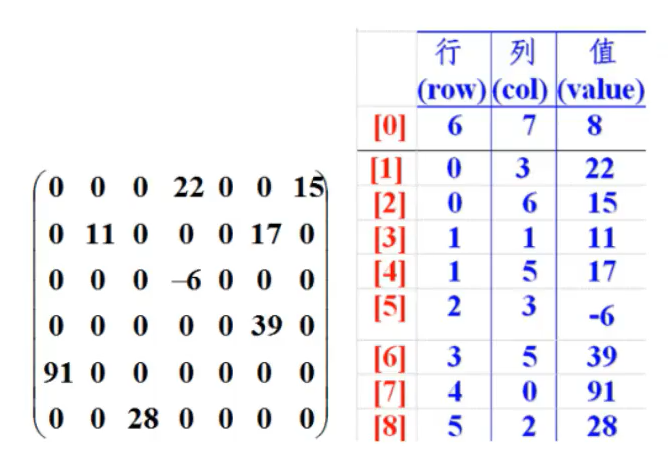
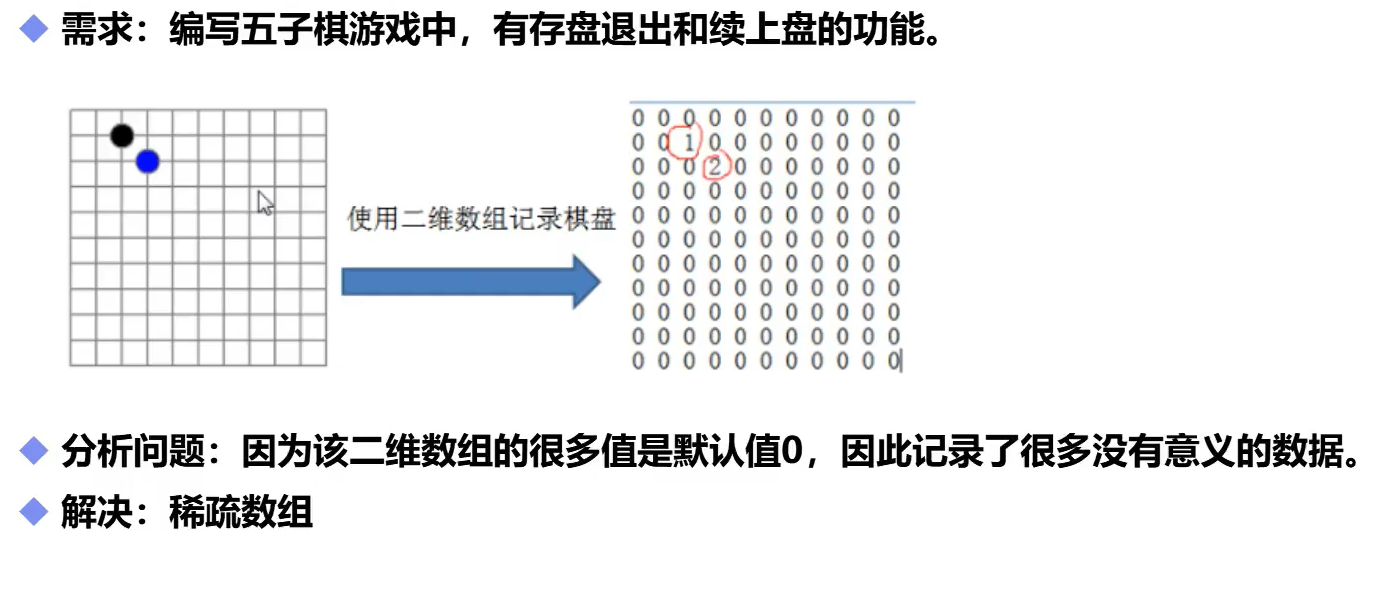
int[][] array1 = new int[11][11];
//Create a binary array 11 * 11 0: no pieces 1: Black 2: white
array1[1][2] = 1;
array1[2][3] = 2;
//Output original array
System.out.println("Output original array:");
for (int[] ints : array1) {
for (int anInt : ints) {
System.out.print(anInt+"\t");
}
System.out.println();
}
Output results:
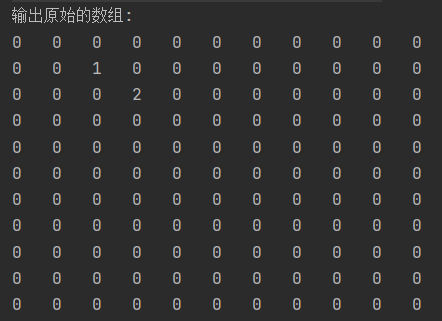
Convert original array to sparse array:
//Convert to sparse array save
//Get the number of valid values
int sum = 0;
for (int i = 0; i < array1.length; i++) {
for (int j = 0; j < array1[i].length; j++) {
if (array1[i][j]!=0){
sum++;
}
}
}
System.out.println("The number of valid values is:"+sum);
//Create an array of sparse arrays
int[][] array2 = new int[sum + 1][3];
array2[0][0] = array1.length;
array2[0][1] = array1[0].length;
array2[0][2] = sum;
int count = 0;
for (int i = 0; i < array1.length; i++) {
for (int j = 0; j < array1[i].length; j++) {
if (array1[i][j]!=0){
count++;
array2[count][0] = i;
array2[count][1] = j;
array2[count][2] = array1[i][j];
}
}
}
System.out.println("Sparse array:");
for (int i = 0; i < array2.length; i++) {
System.out.println(array2[i][0]+"\t"
+ array2[i][1]+"\t"
+ array2[i][2]+"\t");
}
Output results:
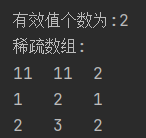
Restore sparse array to original array:
System.out.println("reduction");
//1. Read sparse array
int[][] array3 = new int[array2[0][0]][array2[0][1]];
//2. Restore its value to the element in it
for (int i = 1; i < array2.length; i++) {
array3[array2[i][0]][array2[i][1]] = array2[i][2];
}
//3. Printing
System.out.println("Output restored array:");
for (int[] ints : array1) {
for (int anInt : ints) {
System.out.print(anInt+"\t");
}
System.out.println();
}Output results:
